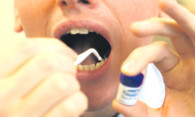
Families living in poverty are resorting to repairing their own teeth because they can’t afford to pay dental bills.
Soaring numbers of people are using DIY dentistry sets to replace loose fillings, caps and crowns. The kits, which cost around £5, can be bought from pound stores and other discount retailers.
One of the biggest manufacturers are Dentek, who sell 250,000 products a year.
Critics claim the rise of DIY dentistry is symptomatic of a “broken society”.
Emma Richardson, of Renfrewshire social support charity the Star Project, said: “It is fairly common around here. They sell a lot of those first aid kits, and you’ve got people taking care of their family’s teeth with them.
“They feel embarrassed to fill out the free prescription form and prefer to get help from friends who don’t judge them as scroungers.”
There are huge regional imbalances in oral health across the UK.
Astonishingly, people living in the poorest areas have eight fewer teeth than those in the richest. In Scotland, just under two thirds of the population have seen a dentist in the past two years.
The proportion is 61% in northern England, 56% in the Midlands and just 50% in London.
John Wildman, professor of health economics at Newcastle University, said: “People at the lower end of the distribution curve, on housing estates in the north-east, for instance, are effectively completely unreported.
“They don’t take part in surveys and they don’t go to GP surgeries. This is why you have a situation where people in the north-east have gaps in their teeth and are resorting to DIY dentistry.”
One in five people have admitted to carrying out DIY dentistry, including pulling out their own teeth, because they couldn’t afford to go to the dentist.
A survey by the British Dental Health Foundation uncovered “senseless” examples of people extracting the wrong tooth and ending up with infections.
Chief executive Dr Nigel Carter said: “DIY dentistry is both dangerous and unnecessary. It is all too easy to make the problem worse, which could result in more invasive and expensive treatment.”
Peter Kelly, of the Poverty Alliance, also blasted the revelations.
He said: “The rise of DIY dentistry illustrates the problems that are becoming increasingly common across the country. Whilst we know that thousands have been forced to turn to foodbanks to make ends meet, a far more common response is to cut back on the things that most people would consider to be an essential.
“Dental health should be considered one of the basics of our health care system.”
A Scottish Government spokeswoman said it advises everyone to use a registered dentist for treatment.
She added: “We are committed to ensuring that everybody who wants access to this service can receive it.”

Enjoy the convenience of having The Sunday Post delivered as a digital ePaper straight to your smartphone, tablet or computer.
Subscribe for only £5.49 a month and enjoy all the benefits of the printed paper as a digital replica.
Subscribe